(345 products available)
































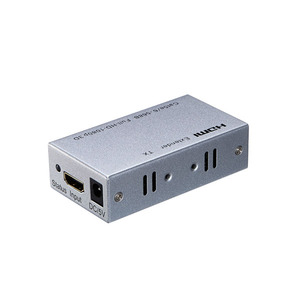































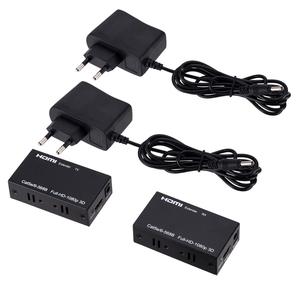
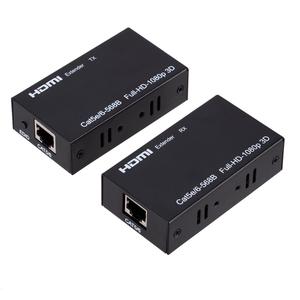
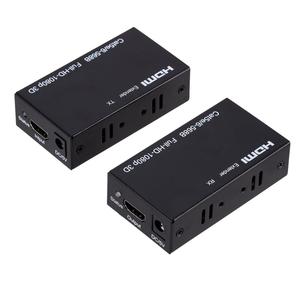
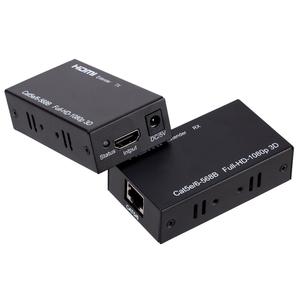
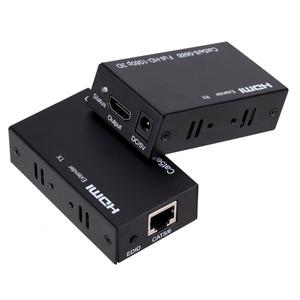

































































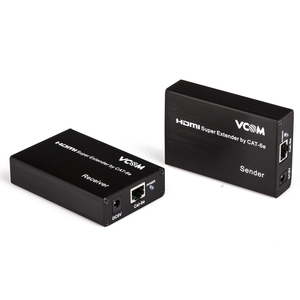



























































































The UTP HDMI extender is a device that sends high-definition audio and video signals over a Cat5e/Cat6 cable. Its main purpose is to extend the length of an HDMI cable run. This device consists of two parts: a transmitter that connects to the source device (e.g., Blu-ray player) and an HDMI cable going to the display; and a receiver unit that gets linked to a standard HDMI cable leading to the TV or monitor at the other end. A Category (Cat) cable then connects the two units in between.
There are several types of UTP HDMI extenders:
Single-Piece Extender (Simplex)
This is an HDMI Extender which, rather than being made up of two separate units that must be placed at either end of the cable run, takes the form of a single device. A single-piece extender can be plugged directly into the source device and run a cable to the display or take any number of intermediate cables between itself and another like unit. Single-piece extenders work best for simple applications where it is convenient to plug an HDMI cable from one point to another without installing two distinct pieces of equipment.
TP-Link HDMI Extender
A typical HDMI extender is known to have trouble transmitting a signal over 100 feet but may succeed in going that far if the surrounding conditions are good. "Good conditions" here would mean things like there not being any noise or interference from other electronic devices nearby, among several other favorable environmental factors. To improve the extender's efficiency and allow it more range, one should use high-quality cables and avoid cheap ones.
Ultra HDMI Extender
Devices in this category can work with longer cable runs of up to 400 feet indoors at 1080p resolution and even longer lengths if lower resolutions are used. They transceive signals via a Cat 5e/6 cable and belong to the UTP type. An essential factor here is that both the HDMI cable going from the source to the regular HDMI port on the TV or monitor and another identical cable join its HDMI OUT port must be good quality for it to achieve long distances.
Features can vary depending on the specific model, but here are some common features of UTP HDMI extenders:
Hikvision UTP HDMI extenders are versatile tools that can be used in various industries and scenarios. Here are some major applications:
Home Entertainment Systems
The extender can be used to distribute high-quality video and audio signals from a source device (like a Blu-ray player, game console, or streaming device) to multiple TVs or monitors located in different rooms or areas of the house.
Digital Signage
Companies in retail, hospitality, transportation, and other industries use HDMI extenders to power their digital signage displays. The devices can transmit the HD content from a central playback device (like a media player or a PC) to the signage displays located in separate areas.
Education
In classrooms, lecture halls, and training centers, HDMI extenders are used to transmit content from teachers' devices to projectors, interactive whiteboards, and displays for students. The UTP cable allows educators to connect their devices easily, even when room configurations require that the cables run through walls or ceilings.
Healthcare Facilities
HDMI extenders could have applications in healthcare environments where medical imaging, patient monitoring, and telemedicine require the transmission of audiovisual content to multiple locations.
Gaming Centers
Game streaming usually requires the transfer of high-resolution video and audio signals to multiple gaming stations or tournament display setups.
Remote Work & Office
The extender can enhance productivity by allowing the extension of a computer or laptop screen to a conference room display or additional monitor without requiring long HDMI cables that can clutter the workplace and pose tripping hazards.
Purchasing a UTP HDMI extender requires consideration of several factors to ensure compatibility and satisfactory performance.
Resolution and Distance
Every application has a maximum distance and resolution that it should be able to efficiently handle. While considering an extender, ensure that it supports the resolution in use (be it 1080P, 4K, etc.) at the required distance. The performance of extenders can differ based on the resolution and distance.
Ethernet Cable Category
The category (Cat 5e, Cat 6, Cat 6a, Cat 7, or Cat 8) of the UTP cable being used can influence the maximum distance the extender can transmit the signal. For optimal performance, particularly at longer distances, extenders compatible with higher category cables should be considered.
Number of Outputs
The number of output ports on a receiver unit should be considered. Some receivers have just one output port, while others have multiple, allowing the simultaneous connection of numerous HDMI devices.
Amplification Feature
For extended distances, consider an extender with signal amplification features to boost the UTP HDMI signal and minimize the risk of quality loss or signal dropouts.
Additional Features
Consider whether features such as IR control (for remote device control) and PoC (Power over Cable) to simplify installation by allowing power supply through the transmission cable) are needed.
Some extenders may also provide resolutions and cast display options, such as mirroring or streaming content, which are crucial for multimedia applications.
Compliance and Certification
Ensure compliance with HDMI and HDCP standards (especially for copy-protected content). Look for certifications that give assurance of performance and compatibility.
Other Considerations
Affordability and budget should be considered, but a cost that is not too high will be selected while ensuring that the extender will meet performance needs. Finally, consider the available ports on the sending and receiving devices. This port arrangement will inform the choice of extender (for example, if a wall-mountable or straightforward cable connector type is needed).
Q1. Can a UTP HDMI extender be used with a network cable other than CAT5 or CAT6?
A1. Ideally, the UTP HDMI extender is designed for use with CAT5 or CAT6 network cables. However, it can work with other types of network cables, such as CAT5e or CAT6a. The quality of the cable will affect the transmission distance and video quality, though.
Q2. Can a UTP HDMI extender be used to transmit power along with the HDMI signal?
A2. Yes, some UTP HDMI extenders include Power over Ethernet (PoE) functionality, allowing them to transmit power to the receiving end via the Ethernet cable. This feature eliminates the need for a separate power supply at the location of the display device.
Q3. What is the maximum resolution a UTP HDMI extender can support?
A3. The maximum resolution depends on the type of extender and the length of cable used. Most UTP HDMI extenders can support resolutions up to 1080p over a distance of 100 meters. Some high-performance models can even support 4K resolutions.
Q4. Is there any signal loss when using a UTP HDMI extender?
A4. HDMI extenders are made to maintain the quality of the HDMI signal over long distances. Nevertheless, factors like cable quality, length, and electromagnetic interference can affect the signal and cause some degradation.
Q5. Can audio be transmitted using a UTP HDMI extender?
A5. Yes, the HDMI signal includes both video and audio. Therefore, an HDMI extender will transmit the accompanying audio signal along with the video signal, allowing users to enjoy synchronized audio and video content at the remote location.